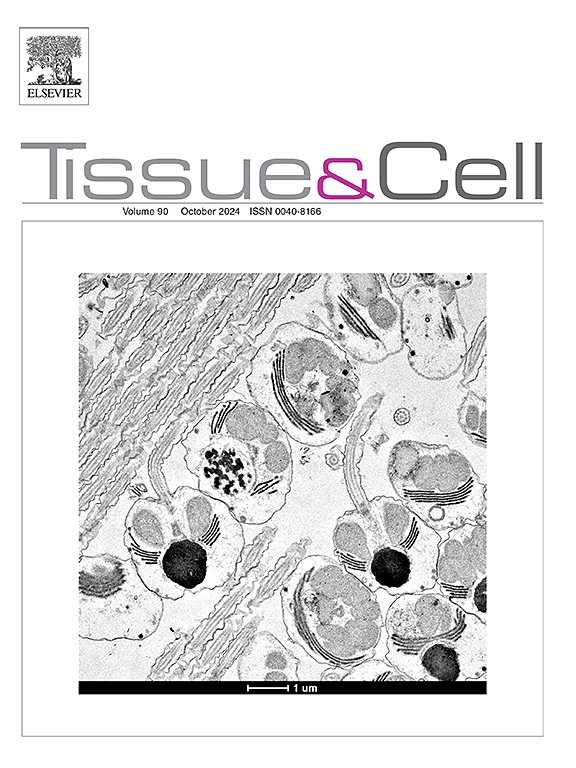橙皮素能否通过其抗氧化、抗凋亡和抗炎特性改善阿霉素诱导的大鼠肾毒性?
IF 2.7
4区 生物学
Q1 ANATOMY & MORPHOLOGY
引用次数: 0
摘要
阿霉素(DOX)是一种广泛应用于各种恶性肿瘤的化疗药物,属于蒽环类药物家族;然而,由于严重的不良反应,特别是对肾脏的不良反应,主要与氧化应激、炎症和细胞凋亡有关,其应用受到限制。橙皮素(HES)是柑橘类水果的衍生物,是一种天然存在的类黄酮。先前的研究通过其已证实的抗氧化、抗细胞凋亡和抗炎特性,强调了HES对几种啮齿动物肾脏损伤的保护作用。本研究探讨了HES对DOX肾毒性的保护作用及其可能的机制。连续6周给药6次等剂量DOX(3 mg/kg/周,ig)诱导大鼠肾毒性。治疗组在DOX的同时给予HES(50 mg/kg/day, p.o.)。测定大鼠体重、肾重、血清肌酐、血尿素氮(BUN)、白蛋白。对肾组织进行处理以评估氧化还原状态、组织病理学和免疫组织化学改变。与对照组相比,HES与DOX联合用药显著降低了血清BUN和肌酐,升高了血清白蛋白,改善了肾小球畸变和小管上皮变性,减少了胶原沉积、血管充血和炎症细胞,并显著降低了炎症细胞因子和促凋亡标志物。我们的研究首次在DOX诱导的肾毒性实验模型中强调了HES的抗氧化、抗凋亡和抗炎活性,并强调了TNF-α、IL-1β和IL-6信号通路,表明HES是一种有效的治疗补充剂,可以减轻DOX的肾毒性作用。本文章由计算机程序翻译,如有差异,请以英文原文为准。
Could hesperetin ameliorate doxorubicin-induced nephrotoxicity in rats via its antioxidant, antiapoptotic, and anti-inflammatory properties?
Doxorubicin (DOX), from the anthracycline family, is a widely utilized chemotherapy for various malignancies; however, its utility is limited due to the serious adverse reactions, particularly on the kidneys, primarily related to oxidative stress, inflammation, and apoptosis. Hesperetin (HES), the citrus fruit derivative, is a naturally occurring flavonoid. Previous studies underscored HES’s protective efficacy against renal damage in several disorders in rodents through its proven antioxidant, antiapoptotic, and anti-inflammatory properties. This work explored the protecting role of HES against the nephrotoxic effects of DOX and the possible underlying mechanisms. Nephrotoxicity was induced in rats via administering six equal doses of DOX (3 mg/kg/week, i.p) for six consecutive weeks. The treated group received HES (50 mg/kg/day, p.o.) simultaneously with DOX. Rats’ body and kidney weights, serum creatinine, blood urea nitrogen (BUN), and albumin were estimated. Kidney tissue was treated to assess redox status, histopathological, and immunohistochemical alterations. Compared to the controls, coadministration of HES with DOX significantly reduced the serum BUN and creatinine, elevated the serum albumin, amended the glomerular distortion and tubular epithelial degeneration, decreased collagen deposition, vascular congestion, and inflammatory cells in addition to the significant attenuation of inflammatory cytokines and proapoptotic markers. Our study is the first of its kind to underscore the HES’s antioxidant, antiapoptotic, and anti-inflammatory activities in an experimental model of DOX-induced nephrotoxicity with emphasis on TNF-α, IL-1β, and IL-6 signaling pathway, rendering it as an effective therapeutic supplement that could alleviate the nephrotoxic effect of DOX.
求助全文
通过发布文献求助,成功后即可免费获取论文全文。
去求助
来源期刊

Tissue & cell
医学-解剖学与形态学
CiteScore
3.90
自引率
0.00%
发文量
234
期刊介绍:
Tissue and Cell is devoted to original research on the organization of cells, subcellular and extracellular components at all levels, including the grouping and interrelations of cells in tissues and organs. The journal encourages submission of ultrastructural studies that provide novel insights into structure, function and physiology of cells and tissues, in health and disease. Bioengineering and stem cells studies focused on the description of morphological and/or histological data are also welcomed.
Studies investigating the effect of compounds and/or substances on structure of cells and tissues are generally outside the scope of this journal. For consideration, studies should contain a clear rationale on the use of (a) given substance(s), have a compelling morphological and structural focus and present novel incremental findings from previous literature.
 求助内容:
求助内容: 应助结果提醒方式:
应助结果提醒方式:


